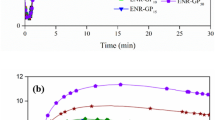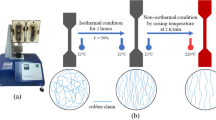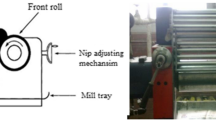Abstract
The effect of incorporating a combination of hybrid carbon fillers, graphene (GP), and carbon nanotubes (CNT) into epoxidized natural rubber with 25 mol% epoxidations (ENR-25) nanocomposites was investigated. The results demonstrated significant effects of CNT incorporation in ENR-25/GP–CNT hybrid composites on the cure characteristics, including shorter scorch and cure times, lower activation energy, and higher torque difference as the CNT loading increased. Fourier Transform Infrared analysis revealed a decrease in absorption intensity at a wavenumber of 1115 cm−1 with increasing CNT loadings. This observation can be attributed to chemical interactions between the polar functional groups in the ENR molecules and the polar groups on the CNT surfaces. Additionally, the hybrid GP–CNT filler was found to improve the mechanical properties, such as modulus and hardness, of the ENR/GP–CNT hybrid composites. The crosslink densities of the hybrid composites were measured using the Flory–Rehner theory, showing an increasing trend with higher CNT loadings. This phenomenon can be explained by the formation of end-to-end connections between certain parts of the CNT and the GP, leading to the establishment of a three-dimensional filler network with strong interactions among the components. Consequently, this facilitates the good dispersion and distribution of CNT within the composites. The observed trends in the mechanical properties were consistent with an increasing Payne effect and electrical conductivity as the CNT loadings increased. Notably, it was found that the ENR/GP–CNT hybrid composites exhibited a low percolation threshold concentration of 2.34 phr of CNT, indicating that they behave as conductive rubber materials.













Similar content being viewed by others
Data and code availability
In response to legitimate requests, the authors will provide relevant data.
References
Ruksakulpiwat C, Nuasaen S, Poonsawat C, Khansawai P (2008) Synthesis and modification of epoxidized natural rubber from natural rubber latex. Adv Mat Res 47:734–737. https://doi.org/10.4028/www.scientific.net/AMR.47-50.734
Baker C, Gelling I (1987) Epoxidized natural rubber. Developments in rubber technology-4. Elsevier, New York. https://doi.org/10.1007/978-94-009-3435-1_3
Nakaramontri Y, Nakason C, Kummerlöwe C, Vennemann N (2015) Influence of modified natural rubber on properties of natural rubber–carbon nanotube composites. Rubber Chem Technol 88:199–218. https://doi.org/10.5254/rct.14.85949
Hong S-G, Chan C-K (2004) The curing behaviors of the epoxy/dicyanamide system modified with epoxidized natural rubber. Thermochim Acta 417:99–106. https://doi.org/10.1016/j.tca.2003.12.015
Srirachya N, Kobayashi T, Boonkerd K (2017) An alternative crosslinking of epoxidized natural rubber with maleic anhydride. Key Eng Mater 748:84–90. https://doi.org/10.4028/www.scientific.net/KEM.748.84
Pire M, Norvez S, Iliopoulos I, Le Rossignol B, Leibler L (2010) Epoxidized natural rubber/dicarboxylic acid self-vulcanized blends. Polymer 51:5903–5909. https://doi.org/10.1016/j.polymer.2010.10.023
Fan Y, Fowler GD, Zhao M (2020) The past, present and future of carbon black as a rubber reinforcing filler: a review. J Clean Prod 247:119115. https://doi.org/10.1016/j.jclepro.2019.119115
Das A, Kasaliwal GR, Jurk R, Boldt R, Fischer D, Stöckelhuber KW, Heinrich G (2012) Rubber composites based on graphene nanoplatelets, expanded graphite, carbon nanotubes and their combination: a comparative study. Compos Sci Technol 72:1961–1967. https://doi.org/10.1016/j.compscitech.2012.09.005
Guo H, Ji P, Halász IZ et al (2020) Enhanced fatigue and durability properties of natural rubber composites reinforced with carbon nanotubes and graphene oxide. Materials 13:5746. https://doi.org/10.3390/ma13245746
Pradhan B, Srivastava SK (2014) Synergistic effect of three-dimensional multi-walled carbon nanotube–graphene nanofiller in enhancing the mechanical and thermal properties of high-performance silicone rubber. Polym Int 63:1219–1228. https://doi.org/10.1002/pi.4627
Yang B, Wang S, Song Z, Liu L, Li H, Li Y (2021) Molecular dynamics study on the reinforcing effect of incorporation of graphene/carbon nanotubes on the mechanical properties of swelling rubber. Polym Test 102:107337. https://doi.org/10.1016/j.polymertesting.2021.107337
Park S, Ruoff RS (2009) Chemical methods for the production of graphenes. Nat Nanotechnol 4:217–224. https://doi.org/10.1038/nnano.2009.58
Bruna M, Borini S (2009) Optical constants of graphene layers in the visible range. Appl Phys Lett 94:031901. https://doi.org/10.1063/1.3073717
Hwangbo Y, Lee C-K, Kim S-M et al (2014) Fracture characteristics of monolayer CVD-graphene. Sci Rep 4:4439. https://doi.org/10.1038/srep04439
Martins LG, Song Y, Zeng T, Dresselhaus MS, Kong J, Araujo PT (2013) Direct transfer of graphene onto flexible substrates. Proc Natl Acad Sci 110:17762–17767. https://doi.org/10.1073/pnas.1306508110
Lv H, Wu H, Liu J et al (2013) High carrier mobility in suspended-channel graphene field effect transistors. Appl Phys Lett 103:193102. https://doi.org/10.1063/1.4828835
Ghosh D, Calizo I, Teweldebrhan D et al (2008) Extremely high thermal conductivity of graphene: prospects for thermal management applications in nanoelectronic circuits. Appl Phys Lett 92:151911. https://doi.org/10.1063/1.2907977
Worsley MA, Pauzauskie PJ, Olson TY, Biener J, Satcher JH Jr, Baumann TF (2010) Synthesis of graphene aerogel with high electrical conductivity. J Am Chem Soc 132:14067–14069. https://doi.org/10.1021/ja1072299
Sa K, Mahakul PC, Subramanyam B, Raiguru J, Das S, Alam I, Mahanandia P (2018) Effect of reduced graphene oxide-carbon nanotubes hybrid nanofillers in mechanical properties of polymer nanocomposites. IOP Conf Ser Mater Sci Eng 338:012055. https://doi.org/10.1088/1757-899X/338/1/012055
Zulhairun AK, Abdullah MS, Ismail AF, Goh PS (2019) Graphene and CNT technology. In: Basile A, Curcio E, Inamuddin (eds) Current trends and future developments on (bio-) membranes. Elsevier, New York, pp 3–26. https://doi.org/10.1016/B978-0-12-813551-8.00001-2
Krainoi A, Kummerlöwe C, Nakaramontri Y, Vennemann N, Pichaiyut S, Wisunthorn S, Nakason C (2018) Influence of critical carbon nanotube loading on mechanical and electrical properties of epoxidized natural rubber nanocomposites. Polym Test 66:122–136. https://doi.org/10.1016/j.polymertesting.2018.01.003
Liu Y, Huang J, Zhou F, Ni L, Shen Y, Liu W, Meng F (2021) A mini-review of three-dimensional network topological structure nanocomposites: preparation and mechanical properties. Nanotechnol Rev 10:1425–1437. https://doi.org/10.1515/ntrev-2021-0094
Szeluga U, Kumanek B, Trzebicka B (2015) Synergy in hybrid polymer/nanocarbon composites. A review. Compos A Appl Sci Manuf 73:204–231. https://doi.org/10.1016/j.compositesa.2015.02.021
Nam K-H, Yu J, You N-H, Han H, Ku B-C (2017) Synergistic toughening of polymer nanocomposites by hydrogen-bond assisted three-dimensional network of functionalized graphene oxide and carbon nanotubes. Compos Sci Technol 149:228–234. https://doi.org/10.1016/j.compscitech.2017.06.025
Siriwas T, Pichaiyut S, Susoff M, Petersen S, Nakason C (2023) Graphene-filled natural rubber nanocomposites: influence of the composition on curing, morphological, mechanical, and electrical properties. Express Polym Lett. https://doi.org/10.3144/expresspolymlett.2023.61
Yangthong H, Wisunthorn S, Pichaiyut S, Nakason C (2019) Novel epoxidized natural rubber composites with geopolymers from fly ash waste. Waste Manag 87:148–160. https://doi.org/10.1016/j.wasman.2019.02.013
Flory PJ, Rehner J Jr (1943) Statistical mechanics of cross-linked polymer networks I. Rubberlike elasticity. J Chem Phys 11:512–520. https://doi.org/10.1063/1.1723791
Flory PJ (1941) Molecular size distribution in three dimensional polymers. II. Trifunctional branching units. J Am Chem Soc 63:3091–3096. https://doi.org/10.1021/ja01856a062
Ojogbo E, Tzoganakis C, Mekonnen TH (2021) Effect of extrusion, batch-mixing, and co-coagulation on the dispersion of CNCs in natural rubber-CNC nanocomposites. Compos A Appl Sci Manuf 149:106580. https://doi.org/10.1016/j.compositesa.2021.106580
Payne A (1965) Effect of dispersion on the dynamic properties of filler-loaded rubbers. J Appl Polym Sci 9:2273–2284. https://doi.org/10.1002/app.1965.070090619
Krainoi A, Kummerlöwe C, Nakaramontri Y et al (2020) Novel natural rubber composites based on silver nanoparticles and carbon nanotubes hybrid filler. Polym Compos 41:443–458. https://doi.org/10.1002/pc.25378
Du F, Fischer JE, Winey KI (2003) Coagulation method for preparing single-walled carbon nanotube/poly (methyl methacrylate) composites and their modulus, electrical conductivity, and thermal stability. J Polym Sci B Polym Phys 41:3333–3338. https://doi.org/10.1002/polb.10701
Omonov TS, Curtis JM (2016) Plant oil-based epoxy intermediates for polymers. In: Madbouly SA, Zhang C, Kessler MR (eds) Bio-based plant oil polymers and composites. Elsevier, New York, pp 99–125. https://doi.org/10.1016/B978-0-323-35833-0.00007-4
Coates J (2000) Interpretation of infrared spectra, a practical approach. In: Meyers RA (ed) Encyclopedia of analytical chemistry. Wiley, Hoboken, pp 10815–10837. https://doi.org/10.1002/9780470027318.a5606
Krainoi A, Kummerlöwe C, Vennemann N, Nakaramontri Y, Pichaiyut S, Nakason C (2019) Effect of carbon nanotubes decorated with silver nanoparticles as hybrid filler on properties of natural rubber nanocomposites. J Appl Polym Sci 136:47281. https://doi.org/10.1002/app.47281
Kitisavetjit W, Nakaramontri Y, Pichaiyut S, Wisunthorn S, Nakason C, Kiatkamjornwong S (2021) Influences of carbon nanotubes and graphite hybrid filler on properties of natural rubber nanocomposites. Polym Test 93:106981. https://doi.org/10.1016/j.polymertesting.2020.106981
Yazid H, Anwar UA, Zaubidah AS et al (2022) A combined method to probe the behaviour of the filler in polymer blend nanocomposites via X-ray diffraction and thermal measurement. Nanostruct Nanoobj 32:100906. https://doi.org/10.1016/j.nanoso.2022.100906
Kim P, Shi L, Majumdar A, McEuen PL (2001) Thermal transport measurements of individual multiwalled nanotubes. Phys Rev Lett 87:215502. https://doi.org/10.1103/PhysRevLett.87.215502
Nakaramontri Y, Kummerlöwe C, Nakason C, Vennemann N (2014) Effect of modified natural rubber and functionalization of carbon nanotubes on properties of natural rubber composites. Adv Mat Res 844:301–304. https://doi.org/10.4028/www.scientific.net/AMR.844.301
Hernández M, del Mar BM, Verdejo R, Ezquerra TA, López-Manchado MA (2012) Overall performance of natural rubber/graphene nanocomposites. Compos Sci Technol 73:40–46. https://doi.org/10.1016/j.compscitech.2012.08.012
Pongdong W, Nakason C, Kummerlöwe C, Vennemann N (2015) Influence of filler from a renewable resource and silane coupling agent on the properties of epoxidized natural rubber vulcanizates. J Chem. https://doi.org/10.1155/2015/796459
Ozawa T (1965) A new method of analyzing thermogravimetric data. Bull Chem Soc Jpn 38:1881–1886. https://doi.org/10.1246/bcsj.38.1881
Zhang X, Niu K, Song W, Yan S, Zhao X, Lu Y, Zhang L (2019) The effect of epoxidation on strain-induced crystallization of epoxidized natural rubber. Macromol Rapid Commun 40:1900042. https://doi.org/10.1002/marc.201900042
Damampai K, Pichaiyut S, Dasa A, Nakason C (2022) Internal polymerization of epoxy group of epoxidized natural rubber by ferric chloride filled with carbon nanotubes: mechanical, morphological, thermal and electrical properties of rubber vulcanizates. Express Polym Lett 16:812–826. https://doi.org/10.3144/expresspolymlett.2022.60
Chenal J-M, Gauthier C, Chazeau L, Guy L, Bomal Y (2007) Parameters governing strain induced crystallization in filled natural rubber. Polymer 48:6893–6901. https://doi.org/10.1016/j.polymer.2007.09.023
Kraus G (1963) Swelling of filler-reinforced vulcanizates. J Appl Polym Sci 7:861–871. https://doi.org/10.1002/app.1963.070070306
Yaragalla S, Meera A, Kalarikkal N, Thomas S (2015) Chemistry associated with natural rubber–graphene nanocomposites and its effect on physical and structural properties. Ind Crops Prod 74:792–802. https://doi.org/10.1016/j.indcrop.2015.05.079
Yang G, Liao Z, Yang Z, Tang Z, Guo B (2015) Effects of substitution for carbon black with graphene oxide or graphene on the morphology and performance of natural rubber/carbon black composites. J Appl Polym Sci. https://doi.org/10.1002/app.41832
Meera A, Said S, Grohens Y, Thomas S (2009) Nonlinear viscoelastic behavior of silica-filled natural rubber nanocomposites. J Phys Chem C 113:17997–18002. https://doi.org/10.1021/jp9020118
Ponnamma D, Sadasivuni KK, Strankowski M, Guo Q, Thomas S (2013) Synergistic effect of multi walled carbon nanotubes and reduced graphene oxides in natural rubber for sensing application. Soft Matter 9:10343–10353. https://doi.org/10.1039/c3sm51978c
Dong B, Liu C, Lu Y, Wu Y (2015) Synergistic effects of carbon nanotubes and carbon black on the fracture and fatigue resistance of natural rubber composites. J Appl Polym Sci. https://doi.org/10.1002/app.42075
Vavouliotis A, Fiamegou E, Karapappas P, Psarras G, Kostopoulos V (2010) DC and AC conductivity in epoxy resin/multiwall carbon nanotubes percolative system. Polym Compos 31:1874–1880. https://doi.org/10.1002/pc.20981
Dalmas F, Dendievel R, Chazeau L, Cavaillé J-Y, Gauthier C (2006) Carbon nanotube-filled polymer composites. Numerical simulation of electrical conductivity in three-dimensional entangled fibrous networks. Acta Mater 54:2923–2931. https://doi.org/10.1016/j.actamat.2006.02.028
Ma P-C, Siddiqui NA, Marom G, Kim J-K (2010) Dispersion and functionalization of carbon nanotubes for polymer-based nanocomposites: a review. Compos A Appl Sci Manuf 41:1345–1367. https://doi.org/10.1016/j.compositesa.2010.07.003
Bhattacharyya S, Sinturel C, Bahloul O, Saboungi M-L, Thomas S, Salvetat J-P (2008) Improving reinforcement of natural rubber by networking of activated carbon nanotubes. Carbon 46:1037–1045. https://doi.org/10.1016/j.carbon.2008.03.011
Sohi N, Bhadra S, Khastgir D (2011) The effect of different carbon fillers on the electrical conductivity of ethylene vinyl acetate copolymer-based composites and the applicability of different conductivity models. Carbon 49:1349–1361. https://doi.org/10.1016/j.carbon.2010.12.001
Ravindran AR, Feng C, Huang S, Wang Y, Zhao Z, Yang J (2018) Effects of graphene nanoplatelet size and surface area on the AC electrical conductivity and dielectric constant of epoxy nanocomposites. Polymers 10:477. https://doi.org/10.3390/polym10050477
Acknowledgements
The authors would like to acknowledge financial support by the National Research Council of Thailand (NRCT) under Grant No. NRCT-RGJ63019-159. Moreover, Faculty of Science and Industrial Technology, Prince of Songkla University Surat Thani campus and University of Applied Science, Osnabrück, Germany are highly acknowledged for access to facilities and equipment.
Author information
Authors and Affiliations
Contributions
TS was performed investigation, analysis, and wrote the original draft. SP1 was managed the data and contributed to writing the review. MS was provided supervision, supplied laboratory facilities, and confirmed the results. SP2 was interpreted the findings. CN was supervised the project, validated the results, reviewed and edited the manuscript, and contributed to its completion.
Corresponding author
Ethics declarations
Conflict of interest
The authors declare that they have no conflict of interest.
Additional information
Handling Editor: Gregory Rutledge.
Publisher's Note
Springer Nature remains neutral with regard to jurisdictional claims in published maps and institutional affiliations.
Rights and permissions
Springer Nature or its licensor (e.g. a society or other partner) holds exclusive rights to this article under a publishing agreement with the author(s) or other rightsholder(s); author self-archiving of the accepted manuscript version of this article is solely governed by the terms of such publishing agreement and applicable law.
About this article
Cite this article
Siriwas, T., Pichaiyut, S., Susoff, M. et al. Enhancing curing, mechanical and electrical properties of epoxidized natural rubber nanocomposites with graphene and carbon nanotubes hybrid fillers. J Mater Sci 58, 15676–15695 (2023). https://doi.org/10.1007/s10853-023-09003-3
Received:
Accepted:
Published:
Issue Date:
DOI: https://doi.org/10.1007/s10853-023-09003-3




